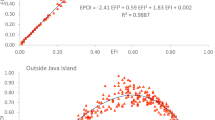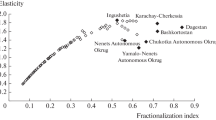Abstract
A number of developing countries have been experiencing high rates of ethnic fragmentation, corruption and political instability. The persistent poverty in many of these countries has led to an increased interest among both researchers and policy makers as to how these factors impact a country’s economic growth. Previous research has found mixed results as to whether ethnic fragmentation, corruption and political instability affect economic growth. However, this research has been focused on the direct impact of these variables on growth. This paper innovates by empirically modelling the impact of ethnic fractionalization and corruption on economic growth, both directly and indirectly through their role in affecting political stability. The analyses also add to the literature by testing a new data set with both fixed effects and GMM estimators. Results from a large panel data set of 157 countries from 1996–2014 finds that ethnic fractionalization and corruption negatively impact economic growth indirectly by increasing political instability, which has a negative direct effect on economic growth. Once the indirect effects are accounted for, ethnic fractionalization has no significant direct effect on growth. There is weak evidence to suggest that corruption may, in some countries, actually have a positive direct effect on growth by enabling firms to circumvent bureaucratic red tape, consistent with the “greasing the wheels” hypothesis. These results emphasize the importance of establishing strong institutions which are able to accommodate diverse groups and maintain political stability. Additional results find these implications to be particularly relevant for low-income and/or sub-Saharan African countries. The results also suggest that a country having a wide diversity of languages and religions need not be a hindrance to economic growth if a robust political system is in place.


Similar content being viewed by others
Notes
For the sake of brevity, these results are available on request.
For the sake of brevity, the GMM results with 1791 observations are available on request.
References
Acemoglu D, Robinson J (2006a) Economic origins of dictatorship and democracy. Cambridge University Press, Boston
Acemoglu D, Robinson J (2006b) Economic backwardness in political perspective. Am Polit Sci Rev 100(1):115–131
Acemoglu D, Robinson J (2012) Why nations fail: the origins of power, prosperity, and poverty. Crown Business, New York
Ades AF, Glaeser EL (1999) Evidence on growth, increasing returns, and the extent of the market. Q J Econ 114(3):1025–1045
Alesina A, Devleeschauwer A, Easterly W, Kurlat S, Wacziarg R (2003) Fractionalization. J Econ Growth 8:155–194
Alesina A, La Ferrara E (2005) Ethnic diversity and economic performance. J Econ Lit 43:762–800
Alesina A, Ozler S, Roubini N, Swagel P (1996) Political instability and economic growth. J Econ Growth 1(2):189–211
Alesina A, Perotti R (1993) Income distribution, political instability, and investment. NBER Work Pap Ser 4486:1–33
Alesina A, Rodrik D (1994) Distributive politics and economic growth. Q J Econ 109(2):465–490
Alesina A, Spolaore E, Wacziarg R (2000) Economic integration and political disintegration. Am Econ Rev 90(5):1276–1296
Ali AB, Crain WM (2002) Institutional distortions, economic freedom, and growth. Cato J 21(3):415–426
Annett A (2001) Social fractionalization, political instability, and the size of government. IMF Staff Pap 48(3):561–592
Aschauer DA (1990) Why is infrastructure important? Fed Reserve Bank Boston Conf Ser 34:21–68
Ashraf Q, Galor O (2013) The ‘out of Africa’ hypothesis, human genetic diversity, and comparative economic development. Am Econ Rev 103(1):1–46
Barro RJ (1991) Economic growth in a cross-section of countries. Q J Econ 106(2):407–443
Barro RJ, Sala-i-Martin X (1995) Economic growth. McGraw-Hill, New York
Benhabib J, Spiegel MM (1994) The role of human Capital in Economic Development: evidence from aggregate cross-country and regional U.S. data. J Monet Econ 34(2):143–173
Blackburn K, Bose N, Haque ME (2010) Endogenous corruption in economic development. J Econ Stud 37:4–25
Blanco L, Grier R (2009) Long live democracy: the determinants of political instability in Latin America. J Dev Stud 45(1):76–95
Brander JA, Dowrick S (1994) The role of fertility and population in economic growth: empirical results from aggregate cross-National Data. J Popul Econ 7(1):1–25
Chew J (2016) These Are the Most Corrupt Countries in the World http://fortune.com/2016/01/27/transparency-corruption-index/
Collier P, Hoeffler A (1998) On economic causes of civil war. Oxf Econ Pap 50(4):563–573
Collier P (2000) Ethnicity, politics, and economic performance. Econ Polit 12(3):225–245
Collier P (2001) Ethnic diversity: an economic analysis. Econ Policy 32:129–166
Davoodi HR, Tanzi V (1997) Corruption, public investment, and growth. IMF Work Pap 97(139):1–23
Dawson JW (2003) Causality in the freedom-growth relationship. Eur J Polit Econ 19(3):479–495
De Haan J, Siermann CLJ (1995) A sensitivity analysis of the impact of democracy on economic growth. Empir Econ 20(2):197–215
De Haan J, Siermann CLJ (1996) New evidence on the relationship between democracy and economic growth. Public Choice 86(1):175–198
Desmet K, Ortuno-Ortin I, Wacziarg R (2015) Culture, ethnicity and diversity. NBER working paper no. 20989. National Bureau of economic research. Cambridge
Easterly W, Levine R (1997) Africa’s growth tragedy: policies and ethnic divisions. Q J Econ 112(4):1203–1250
Easterly W (2001) Can institutions resolve ethnic conflict? Econ Dev Cult Chang 49(4):687–706
Esteban J, Ray D (1994) On the measurement of polarization. Econometrica 62(4):819–851
Goren E (2014) How ethnic diversity affects economic growth. World Dev 59:275–297
Kimenyi MS (2006) Ethnicity, governance and the provision of public goods. J Afr Econ 15(1):62–99
La Porta R, Lopez-de-Silanes F, Shleifer A, Vishny R (1999) The quality of government. J Law, Econ Org 15(1):222–279
Levine R, Renelt D (1992) A sensitivity analysis of cross-country growth regressions. Am Econ Rev 82(4):942–963
Mauro P (1995) Corruption and growth. Q J Econ 110:681–712
Mo PH, Papyrakis E (2014) Fractionalization, polarization, and economic growth: identifying the transmission channels. Econ Inq 52(3):1204–1218
Montalvo JG, Reynal-Querol M (2005) Ethnic polarization, potential conflict, and civil wars. Am Econ Rev 95(3):796–816
Mulligan CB, Gil R, Sala-i-Martin X (2004) Do democracies have different public policies than nondemocracies? J Econ Perspect 18(1):51–74
Nelson RR, Phelps ES (1966) Investment in Humans, technological diffusion, and economic growth. Am Econ Rev 56(1/2):69–75
Piatek D, Szarzec K, Pilc M (2013) Economic freedom, democracy, and economic growth: a causal investigation in transition countries. Post-Communist Econ 25(3):267–288
Ranis G (2009) Diversity of communities and economic development. Yale Univ Econ Growth Center 977:1–17
Reynal-Querol M (2002) Ethnicity, political systems, and civil wars. J Confl Resolut 46(1):29–54
Roe J, Siegel J (2011) Political instability: effects on financial development, roots in the severity of economic inequality. J Comp Econ 39(3):279–309
Sasaoka Y (2007) Decentralization and conflict. Japanese International Cooperation Agency, 889th Wilton Park conference, pp 1–30
Transparency International (2015) Corruption Perception Index 2015. http://www.transparency.org/cpi2015. Accessed July 2016
World Bank (2016a) Anti-Corruption http://www.worldbank.org/en/topic/governance/brief/anti-corruption. Accessed July 2016
World Bank (2016b) Poverty: Overview http://www.worldbank.org/en/topic/poverty/overview. Accessed July 2016
Author information
Authors and Affiliations
Corresponding author
Appendices
Appendix 1
The 2SLS model was run for the full sample of countries, both with and without the Gini index. The results in the body of the paper excluded the Gini Index. When including the Gini index, the sample only consisted of 754 observations, compared to 1791 observations when excluding the Gini index. When run with the Gini, corruption is found to affect instability, but neither measure of fractionalization nor the Gini index is significant. Religious fractionalization significantly impacts GDP growth, only at the 10% level, and neither political instability nor the Gini index has a significant impact on GDP growth. This does not agree with the findings in the literature. The inclusion of the Gini index may be impacting results as it dramatically lowers the sample size (Tables 4 and 5).
Appendix 2
This appendix contains results with both additional variables and another empirical methodology. A country’s openness to international trade may have a significant impact on its economic growth (Ades and Glaeser 1999; Alesina et al. 2000). In order to test the impact of these factors and to check robustness of the other results, analyses including openness is included in the tables below. These tables include a variable for openness (trade/GDP). The tables below also include a variable representing economic freedom. Tables 6 and 7 contain results using the fixed effect methodology in the body of the paper with these additional variables. An interaction term for openness and initial GDP per capita was also tested but was insignificant so not included in the results. Tables 8 and 9 test these additional variables using a GMM methodology. One of the weaknesses of a 2SLS or similar type of regression analysis is its reliance on functional form. As an additional test of robustness, a generalized method of moments (GMM) methodology is employed on the data. Its usage in this case helps to show that the results are not contingent to specific assumptions regarding functional form.
There is some loss of observations when adding the additional variables. These additional analyses have 1553 observations as opposed to the 1791 observation from the results in the body of the paper. It is worth noting a few differences in the results. One substantial difference in the fixed effects analyses is corruption having a positive direct impact on economic growth. This was consistent with some of the subsample analysis but not with the 1791 observation full sample results (in which corruption’s direct effect was insignificant). For the GMM analysis, the direct impact of corruption on economic growth was insignificant. A relevant difference in the GMM results is the significant, positive effect of instability on economic growth. This occurs in the 1553 observation sample run with GMM. However, instability becomes insignificant if GMM is run with the full 1791 observation sample.Footnote 2
Rights and permissions
About this article
Cite this article
Karnane, P., Quinn, M.A. Political instability, ethnic fractionalization and economic growth. Int Econ Econ Policy 16, 435–461 (2019). https://doi.org/10.1007/s10368-017-0393-3
Published:
Issue Date:
DOI: https://doi.org/10.1007/s10368-017-0393-3




